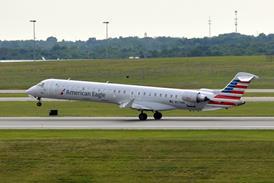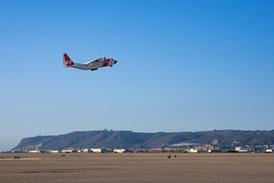As demand for business jets soars, students are learning the attractions of corporate over commercial piloting
Dave Higdon/VERO BEACH, FLORIDA
Looking at the students in a classroom at the FlightSafety International Academy in Vero Beach, Florida, raises the question: How many of them long for an airline career and how many want something else?

Dressed in white uniform shirts with epaulettes, dark trousers, dark socks and polished shoes, the students provide no clues. "That's because at this stage of training, it makes no difference," explains a FlightSafety official. One company manager adds: "They're like good clay, ready to be moulded into what ever type of shape they choose."
Given the similarities and differences between piloting career tracks, inside observers believe the corporate community could enjoy an edge over commercial airlines - if the owners of those cockpits are smart enough to put those advantages to work.
"Today's professional pilots want to fly and enjoy their careers," says the FlightSafety manager. "Folk able to offer that fulfilment will be beating back applicants. But those applicants must first gain the experience to get that job."
Today's business aviation community is challenged by its very growth, reflected in the order backlogs corporate aircraft manufacturers hold which are, if not the longest ever, certainly the largest in nearly a generation.
While manufacturers address the challenge of producing thousands of new business jets and turboprops over the next decade, operators face finding the pilots to fly all the aircraft ordered. The seemingly insatiable appetite for fractional ownership programmes, the increase in in-house flight departments and the expanding population of people wealthy enough to own aircraft must all be catered for. Together these groups will produce a demand for 9,000-10,000 new aircraft in the next 10 years, according to various forecasts. The Teal Group, a US-based aerospace research firm, predicts deliveries through 2010 of nearly 6,700 aircraft from domestic manufacturers alone. Honeywell recently forecasted demand for over 2,700 new turbofan and turboprop aircraft until 2005 just in the USA. Worldwide, the number jumps to more than 4,100 aircraft over the same period.
Regardless of the forecasting source, it is generally agreed that annual average deliveries will approach 1,000 worldwide over this decade. This boom is a dream come true for the general aviation industry. After more than a decade of sales stagnation, the business aviation community - from the makers to the maintainers - now worries more about keeping up than staying afloat. And the challenge of finding enough pilots to fly the new aircraft is as formidable as building them.
Filling the flight decks of nearly 1,000 new aircraft per year means adding 2,500 new corporate pilots annually - more than two thirds of them in the USA.
The number of jobs exceeds the number of new flightdeck seats as most fractional programmes need at least two crews for each aircraft, as do many busy flight departments.
Most forecasts expect fractionals to more than triple their impact. Honeywell's 10-year business turbine aircraft outlook puts the fractional fleet at nearly 1,900 aircraft by 2011, 11% of a total fleet of more than 17,000 business-turbine aircraft. In contrast, fractionals accounted for a mere 4% of the current fleet at year-end - about 400 of 10,000 business aircraft worldwide. Still, those 400 fractional aircraft also accounted for as many as 1,200 crews.

Slower retirement rate
The slower retirement pace for older corporate aircraft is another reason why demand for pilots is high. Forecast numbers anticipate fewer than 3,000 aircraft retirements in this decade, an average of under 300 aircraft per year.
Together, the higher rate of new aircraft versus retirements assures a future of fleet growth and an accompanying demand for crews. General aviation, however, is not alone in its need for new pilots. Commercial air carriers, in the midst of their own growth spurt, absorbed more than 19,000 new recruits last year. The airline industry is expected to generate another 14,000 new flying jobs this year.
For the supply of professional pilots to keep pace with the growth in cockpit jobs, there must be a larger supply of new student pilots each year - and a larger proportion of them determined to make a living from flying.
In recent years, industry promotion efforts have apparently succeeded in attracting students, with the number of new student pilots growing again after hitting bottom in the early 1990s. Industry sources estimate more than 70,000 people started flying training in 2000. Professional training programmes report enrolment at an all-time high - with some better known schools at their limits.
Now is a good time for those who covet a job flying in business aviation, but not for those with jet jobs to fill. About 270,000 commercial and air transport-rated pilots were flying in 2000, according to the US Federal Aviation Administration, barely staffing the airline cockpit and business jet requirements.
The need for pilots shows no sign of slowing. Beyond desire to fly and a track record in training, time counts most for corporate flight department managers. The more flying time the better, particularly where that time is diverse.
Flight International examined the qualifications required by several fractional ownership programmes and corporate flight departments. Similar in most areas, they differed mostly in the fine detail. For example, one fractional programme sought first officer candidates with a total time of 2,500h, 1,500h to be pilot-in-command, 500h for flying multi-engine aircraft and 500h flying turbine-powered aircraft. Looking over seven different employers, the experience required ranged from a high of 3,500h to a low of 1,500h.
Employers' expectations spanned a variety of yardsticks, with 500h multi-engine experience typical, although some were open to candidates with only 300h. A close second was 500h in turbines, while only 100h of turbine time worked for some second-in-command posts. Other entry-level qualifications include a minimum of 250-500h in instrument conditions for a general candidate. More type-specific openings, such as a captain's seat in one new fractional programme's Citations, required 3,500h in total time, 500h in turbine aircraft of which at least 250h were in jets. These times far exceed what the typical graduate gains during four years of aviation training.
So the next step after qualifying is on-the-job training. Some corporate cockpit candidates work their way to the experience level and an air transport pilot rating by booking out as a freelance charter pilot, by logging time as a flight instructor, or by flying night freight - whatever it takes. From here, candidates take various paths. They scrimp and save to buy the aircraft or simulator time and ratings they cannot earn on the job - their commercial licence, instrument rating, multi-engine licence or even the air transport pilot licence check ride. With the minimum time of 500h pilot in command, 50h of multi-engine time, a commercial licence and an instrument ratings in hand, first-officer jobs for small charter carriers are generally available. From there, it shouldn't take long to move up.
"The magic number we look for is 1,000h, with enough multi-engine and instrument time to know they've been flying seriously toward a career," says the marketing executive of a major Midwest charter-operator. "We've become the interim step between entry-level jobs and working for a corporate flight department or fractional carrier.
"We have little trouble recruiting from the ranks of night freight pilots, and a lot of trouble holding on to pilots drawn by little things others offer, like bigger pay, better benefits, newer equipment and regular hours," he jokes.
Living well versus paying well
The difference in lifestyle can go a long way to levelling the playing field between corporate and commercial flying. "We offer our guys a choice of domiciles," says an executive with a fractional programme.
Among the attractions, another fractional executive says, is the variety of destinations, the lighter individual work days, and the opportunity to fly equipment with state-of-the-art flight decks. "The pay-per-segment works out to be better than what a lot of them made flying for commercial carriers," he adds.

The combination seems to attract a fair share of airline pilots. "I had a choice for advancement," a fractional captain in Texas says. "I could either stay in the left seat of a short-hop narrowbody and fly six to eight segments a day, or bid up to a widebody - and move to the left seat and junior status again."
Instead, this captain in his forties made a jump to a growing corporate flight department, where his year of right-seat time in a mid-size corporate jet logged years ago qualified him for the left seat corporate job he now holds.
"The equipment is more up-to-date, the variety [of destinations] is more interesting, the clientele more appreciative," he says. "I'm having more fun and expect to earn close to the same as my airline job in a couple years."
Money talks
The appeal of the corporate aircraft flight deck includes fewer hassles, fewer daily segments, friendlier management, more enjoyment. But money does not hurt and where the pay cheque meets the flight bag, corporate flying holds its own. "We offer first officer [candidates] a starting pay the regional carriers cannot match, plus the flexibility of six-on/four-off schedules," explains the fractional executive.
Overall, corporate flying tends to pay well enough for the flying involved, which typically ranges from 350h to 600h annually - well below the 1,000h-per-year limit FAA rules impose on airline pilots. One recruiting group's annual salary survey found the average corporate pilot earned nearly $62,000 in 2000. The median salary - halfway between highest and lowest - came in at $58,000. And the most common annual pay was $60,000.
That said, there is variation in pay, depending on equipment type and seating position. In light jets, for example, captains enjoyed a median salary in the mid-50s; for mid-size jet captains, the median hits the high-60s; for heavy-jet pilots-in-command (PICs), the median made the low-90s. And that means some broke the six-figure barrier.
First officer salaries tended to run 20 to 25% behind captains in the same range of equipment - still above the entry level salaries of most regionals and some major carriers.
The best paying jobs were in corporate flight departments and fractional programmes - anywhere the operations flown were all Part 91. At companies where the operations split between Part 91 private, not-for-hire flying and Part 135 for-hire, air taxi rules, salaries ran lower. The lowest salaries, according to this pilot jobs clearing house, came from pure Part 135 charters.
"Can we compete with the biggest carriers for our captains?" the fractional executive asks rhetorically. "Not generally on salaries alone, which can run from 10 to 30% higher [at the airlines]. But then, enjoying work and having a good lifestyle seldom is an issue simply of money."
This combination may become the standard if corporate operators hope to staff all the new flight decks of the next decade.
Source: Flight International























